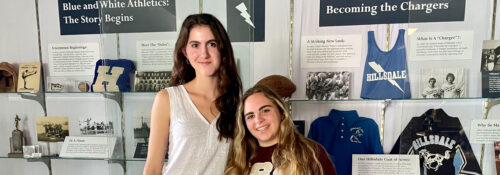
Uncovering Charger History
Written by Stephanie Gordon
Enter the Sports Complex lobby, and you are welcomed by three display cases highlighting the rich history of Hillsdale Charger athletics. From jerseys to helmets, to photos and even a poem, three students in the Museum Studies program – Anna Bassols, ’24, Hope Schlosser, ’24, and Moira Schmitt, ’23—uncovered Charger artifacts from more than 100 years of Hillsdale athletic history. For these three women, sharing and preserving Charger history was not only necessary, but an honor.
“Museum studies was a one-credit class we took in the spring 2022 semester with [Professor of History] Dr. Dave Stewart,” Hope said. “The class, and these displays, show the value of museum studies. Anna, Moira, and I are all interested in careers in museum studies, so this was a great experience.”
According to Dr. Stewart, the field of museum studies is important because every year, more Americans visit museums than watch news on television and the internet combined. Moreover, for the past two decades, polls have consistently named museums as Americans’ most trusted and least biased source of news, history, and science. Given this vital role in American public discourse, Hillsdale wants to encourage and prepare students who wish to pursue this profession, just as the College does with journalism, education, and other curricula.
Anna said the Sports Complex display project was not a requirement of the class; rather, a project presented to Dr. Stewart by the Athletic Department to help showcase Charger history and celebrate the new athletic rebrand. Dr. Stewart approached the three women and offered the opportunity to them. They had several weeks to complete the cases after the spring semester concluded. “Based on their excellent work, active participation, and eager engagement in that class, they sprang immediately to mind when the Athletic Department mentioned the idea,” said Dr. Stewart.
The women went into the project blind, and admitted that getting started was the hardest part. “We started going through the Winona yearbooks and Hillsdale history books,” said Anna. “We were told about photo archives in the library that weren’t digitized. We spent a week just going through the archives and looking for photos and digitizing them. We couldn’t have done this without the library staff.”
Once they completed their research, Anna, Hope, and Moira contacted athletic teams and alumni and requested memorabilia to use in the cases. “We had overwhelming responses,” said Anna. “The alums really wanted to support Hillsdale and be involved with telling the story.”
The women then organized artifacts and photos in chronological order and uncovered history dating back to the 1800s. They found unique pieces of history like an embroidered patch from the Women’s Athletic Association that is believed to be from the early 20th century. “It’s really interesting because our school has had women’s athletics from the beginning; we are very egalitarian in that way,” Anna said.
The display made it obvious that there was a sudden shift into an identity when the student body voted to adopt the Charger nickname in 1968. For the 1969 Homecoming, an actual horse, aptly named “Hillsdale,” took to the football field. But as the College adopted the Charger, there wasn’t one clear image of what the Charger was. Sports teams were left to interpret their own version of a Charger. “During our research, we jokingly called this era the Cambrian explosion of Charger athletics,” Hope said. “We discovered at least six different Charger variations.”
Artifacts also proved that there were several shades of blue for sports teams, and the lightning bolt made its appearance in 1962, becoming an unintentional staple of Hillsdale iconography for the football team. “There was inconsistency of what the Charger was supposed to look like, and there was an explosion of so many different looks,” Hope said.
According to the women, this is the whole purpose of the display cases. “It’s this whole conundrum,” said Hope. “The purpose of the display cases is to do the history justice, but also justify why we needed this rebranding to unify all of Hillsdale athletics.”
Anna, Hope, and Moira believe the athletic rebrand is an especially good opportunity for athletics to unite with the academic image of the College, all while having a Charger horse head that embodies both athletic and academic institutions. They also believe museum studies are an important asset to preserve and display history. “If people don’t know how to properly preserve artifacts and get materials to engage the public and help educate other people, we’re kind of at a loss. Then what’s the point of these beautiful things?” Anna said.
The women discovered a lot of Hillsdale history that they previously did not know. To them, this history deserves to be told. “There’s just a lot that goes hidden until someone knows how to dig it up and knows how to share it properly,” said Anna. “And I think that it really adds to the richness of our history and really emphasizes what a special place Hillsdale College is.”
The display cases in the Sports Complex are intended to be permanent for the foreseeable future, with proper updates and upkeep. Go see Charger athletic history unfold for yourself.
Stephanie Gordon, a lifelong Hillsdale native, is the managing editor of the Student Stories Blog. She is married to chiropractor, Dr. Matt Gordon, and has three children – Eloise, Flora, and Jack. When she has a spare moment, she enjoys paleo baking, floating on Baw Beese Lake, and breaking a sweat at the gym.
Published in August 2022
